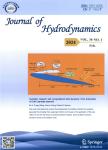NUMERICAL STUDY OF HYDRODYNAMICS OF MULTIPLE TANDEM JETS IN CROSS FLOW
NUMERICAL STUDY OF HYDRODYNAMICS OF MULTIPLE TANDEM JETS IN CROSS FLOW作者机构:State Key Laboratory of Hydrology-Water Resources and Hydraulic Engineering Nanjing 210098 China College of Water Conservancy and Hydropower Engineering Hohai University Nanjing 210098 China Department of Engineering University of Cambridge Cambridge UK
出 版 物:《Journal of Hydrodynamics》 (水动力学研究与进展B辑(英文版))
年 卷 期:2011年第23卷第6期
页 面:806-813页
核心收录:
学科分类:080704[工学-流体机械及工程] 080103[工学-流体力学] 08[工学] 080104[工学-工程力学] 0807[工学-动力工程及工程热物理] 0805[工学-材料科学与工程(可授工学、理学学位)] 0802[工学-机械工程] 0701[理学-数学] 0702[理学-物理学] 0812[工学-计算机科学与技术(可授工学、理学学位)] 0801[工学-力学(可授工学、理学学位)]
基 金:supported by the National Natural Science Foundation of China (Grant Nos. 50879020, 51179055 and 51125034) the Special Fund of State Key Laboratory of Hydrology-Water Resources and Hydraulic Engineering (Grant No. 2010585512) the Fundamental Research Funds for the Central Universities (Grant No. 2009B07614)
主 题:multiple tandem jets jet in cross flow realizable model flow dynamics
摘 要:The hydrodynamics of a single jet and four tandem jets in a cross flow are simulated by using the Computational Fluid Dynamics (CFD) software Fluent. The realizable model is used to close the Reynolds-Averaged equations. The flow characteristics of the jets, including the jet trajectory, the velocity field and the turbulent kinetic energy are obtained with various jet-to-cross flow velocity ratios in the range of 2.38-17.88. It is shown that a single jet penetrates slightly deeper than the first jet in a jet group at the same , although the difference decreases with the decrease of . It is also found that the way in which the velo-city decays along the centerline of the jet is similar for both a single jet and the first jet in a group, and the speed of the decay increases with the decrease of . The downstream jets in a group are found to behave differently due to the sheltering effect of the first jet in the group. Compared with the first jet, the downstream jets penetrate deeper into the cross flow, and the velocity decays more slowly. The circulation zone between the two upstream jets in the front is stronger than those formed between the downstream jets. The Turbulent Kinetic Energy (TKE) sees a distinct double-peak across the cross-sections close to each nozzle, with low values in the jet core and high values in the shear layers. The double-peak gradually vanishes, as the shear layers of the jet merge further away from the nozzle, where the TKE assumes peaks at the jet centerline.



